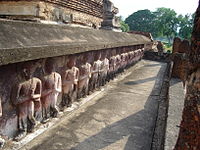Wat Mahathat (Sukhothai)
The Wat Mahathat ( Thai วัด มหาธาตุ - "Temple of the Great Relic") is a Buddhist temple ( wat ) in the district of Sukhothai the province of Sukhothai in northern Thailand . At the time of the kingdom of Sukhothai it was the central and therefore most important temple of the empire.
location
Wat Mahāthāt is in the center of the Sukhothai Historical Park , called "Mueang Khao" (Old City) by the locals.
Building history
It was probably the king Sri Indraditya , who ruled between 1238 and around 1270, who founded today's Wat Mahāthāt. Initially, Sri Indraditya probably only built five towers on a square platform (one at each corner and one in the middle) of the central shrine that is still visible today. This was discovered by the Thai Fine Arts Department in the early 1960s when they were doing repairs there. The temple was probably given its current form by King Loe Thai around 1345.
In the heyday of the kingdom, the walls of Wat Mahāthāt encompassed an area of approximately 200 meters by 200 meters and enclosed nearly two hundred chedis and a number of smaller buildings.
The main building is oriented in a west-east direction and used to stand on a fairly high plinth foundation. A small viharn from the Ayutthaya period precedes it in the east . The Buddha statue on the west side is original and has recently been renovated. Behind it is the bot measuring around 40 m by 15 m . The pillars of the five-nave building still stand and show that the side aisles were narrower and gradually lower than the central nave. On the west side there is a kind of apse , which corresponds to the vestibule on the east side. For this building dates back to Phra Buddha Shakjamuni that on the orders of King Phra Phutthayotfa Chulalok ( I. Rama ) at the beginning of the 19th century to Bangkok in the Wat Suthat was brought.
In the central axis of the bot and the viharn there is a chedi that housed the holy relic. It was rebuilt and enlarged under King Lü Thai and has probably not changed much since then. The chedi rests on a terrace with a square floor plan, the walls of which are decorated with reliefs showing a ritual procession of disciples worshiping the Buddha.
In the south of the temple area lies the ruins of a large stupa with an attached viharn. Most of the leftover chedis can be found here, which come from very different stylistic epochs of Siam and Thailand.
Attractions
In Wat Mahāthāt there are still a number of original Buddha statues from the time of the ancient Sukhothai Kingdom.
literature
- Clarence Aasen: Architecture of Siam: A Cultural History and Interpretation . Oxford: Oxford University Press 1998. ISBN 9835600279 .
Individual evidence
- ^ AB Griswold : Towards A History Of Sukhothai Art. The Fine Arts Department, Bangkok 1967, page 3
Web links
Coordinates: 17 ° 1 ′ 0.3 ″ N , 99 ° 42 ′ 13.5 ″ E



